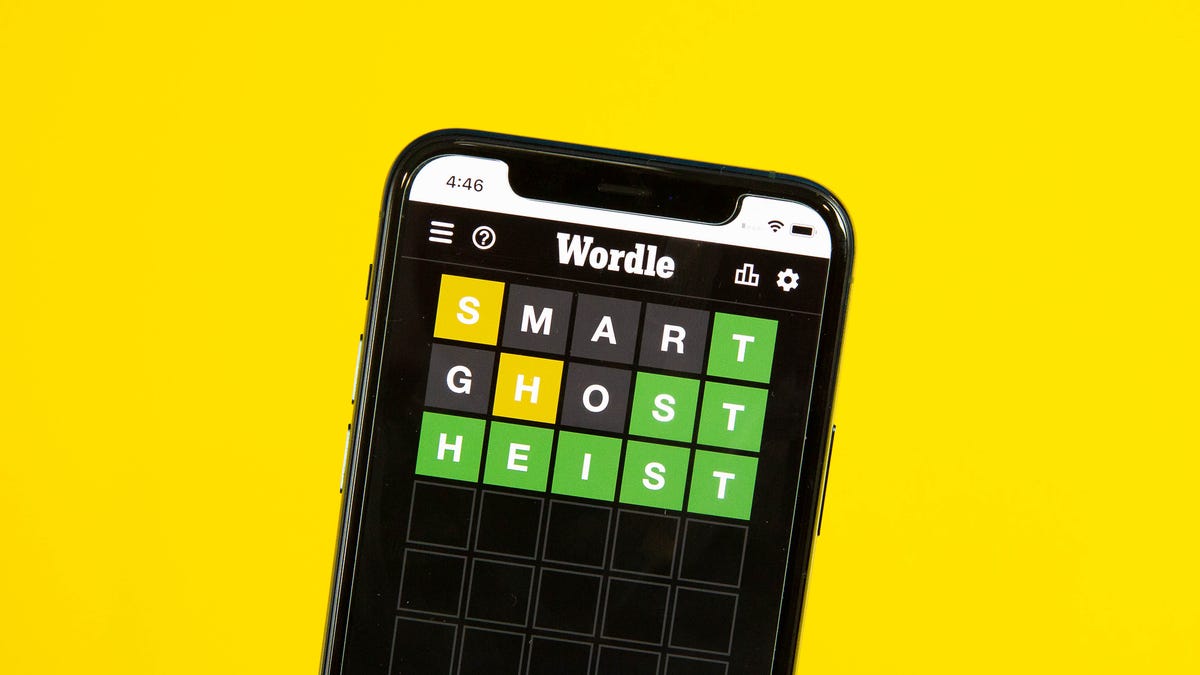Technologies
Let’s Not Forget About Wordle
The feelings we had earlier this year are needed more than ever.

About 100 years ago — or, that’s how long it feels — we were all together, playing Wordle. Well, we weren’t technically together. We were in sunny places, snowy places, other countries, commuting, staying at home. We were together, though. In a sense. And we weren’t screaming.
Little score grids popping up everywhere, instead of historical face filters or randomly generated AI art, or snippets of chatbot-generated text. These grids, these scores. Wordle swept through an Omicron winter where flights were canceled, trips postponed, returns to work delayed again. It was like bread-baking 2.0. Just another viral pandemic moment.
The game was acquired by The New York Times in early February, and I was ready to say goodbye to a moment I always suspected would end sometime. And it did: Scores stopped being shared. Players dwindled. I eventually stopped playing regularly sometime in the late spring, I don’t know when.
I want to go back to that moment. I remember what was going on: I was depressed. I felt disconnected from friends, from family, from anyone. I put random things on Facebook so I could feel like I did something, for just a few moments, to reach out. For a while, it was random food shots of me putting chili crisp in oatmeal. Then it was Wordle scores. I found a little community of old friends who wrote back and shared theirs. We nodded our virtual heads. We connected, just a bit.
These moments may seem frivolous. They’re not. At the end of 2022, where are we? Twitter has been acquired, gutted, and is slowly being transformed. Migrations away from Twitter (or Facebook) to constellations of new platforms, strange new worlds, places like Mastodon or Hive or Post. Social media, at the end of 2022, feels like it’s either on its last legs or struggling to be reborn as something strange, new and — yes, to me — alien.
With everything that 2022 ended up becoming, something like Wordle feels like a ridiculous little footnote, utterly unimportant, perhaps completely pointless. I still think of it as a little spark of connection. A hope for making people feel like they can reach out to each other without hating or escalating or destroying. The whole original idea of social media that seemed so appealing, maybe, a long time ago, was that it could bring familiar faces together and, for just a few moments, create a sensation of connection. My games of Wordle, along with a few special trips into VR with friends, and a few lingering Zooms, were some of the few moments that did that. For all we’re rushing out to see people and connect again in the real world, we forget the moments when connecting virtually actually worked.
I read an article in The Atlantic the other day that spoke deeply to me, about how we’re haunted by the ghosts of 2019. I am. Life in 2022, trying to go back to «normal,» has felt uncanny. I commute now. I’ve gone on flights. I’ve gone to the UK again. None of it felt normal. Some of it felt familiar. Echoes of the old, overlaps of the new.
Slowly but surely, we’re returning to a strange version of the world we once knew — or trying to. How do I move forward here?
I hope, in our rush to return to «normal,» we stay connected to the strange rituals that brought us together in our lowest moments. It doesn’t have to be Wordle — that’s just a word game gone viral. But as we reinvent how we communicate online — via social media or metaverses — I’ll take any help I can get. Show me how we could reconnect and not feel alienated. Wordle was lightning in a bottle, and even though I’ve said goodbye to what it was in that moment, I’ll always be searching for that feeling again.
Technologies
The Most Exciting Video Game Rumors and Leaks Ahead of 2026
Technologies
Today’s NYT Mini Crossword Answers for Wednesday, Dec. 17
Here are the answers for The New York Times Mini Crossword for Dec. 17.

Looking for the most recent Mini Crossword answer? Click here for today’s Mini Crossword hints, as well as our daily answers and hints for The New York Times Wordle, Strands, Connections and Connections: Sports Edition puzzles.
Need some help with today’s Mini Crossword? Read on. And if you could use some hints and guidance for daily solving, check out our Mini Crossword tips.
If you’re looking for today’s Wordle, Connections, Connections: Sports Edition and Strands answers, you can visit CNET’s NYT puzzle hints page.
Read more: Tips and Tricks for Solving The New York Times Mini Crossword
Let’s get to those Mini Crossword clues and answers.
Mini across clues and answers
1A clue: Nod (off)
Answer: DOZE
5A clue: Naval submarine in W.W. II
Answer: UBOAT
7A clue: Tricky thing to do on a busy highway
Answer: MERGE
8A clue: Heat-resistant glassware for cooking
Answer: PYREX
9A clue: Put into groups
Answer: SORT
Mini down clues and answers
1D clue: Break up with
Answer: DUMP
2D clue: Falls in line, so to speak
Answer: OBEYS
3D clue: Legendary vigilante who cuts a «Z» with his sword
Answer: ZORRO
4D clue: Rarin’ to go
Answer: EAGER
6D clue: Common reminder for an upcoming appointment
Answer: TEXT
Don’t miss any of our unbiased tech content and lab-based reviews. Add CNET as a preferred Google source.
Technologies
You Can Watch an Exclusive Avatar: Fire and Ash Scene on TikTok Right Now
Disney and TikTok partner on an immersive content hub for James Cameron’s latest movie about the alien Na’vi.
If you’re not quite ready to head to the theater to watch Avatar: Fire and Ash, an exclusive scene preview might sell you on the visual spectacle. As part of a new collaboration with the social media giant, Disney is posting snippets of its new movie to its TikTok account.
This scene isn’t part of any trailer and won’t be posted to other social media accounts, making TikTok the only place you can view it — unless you buy a movie ticket. A first look at the new movie’s scenes isn’t the only Avatar-related bonus on the social media platform right now, either. TikTok has partnered with the house of mouse to bring an entire «immersive content hub» to the app.
A special section of TikTok includes quizzes and educational videos that explore the alien world of Pandora shown off in the movies. On TikTok, you can take a personality quiz to find out what Na’vi clan you most closely align with and unlock a special profile picture border to use on your account.
Science and fiction blend together with a series of videos from real doctors who explain the basis for some of Avatar’s world-building. If you want to learn about exoplanets or how realistic the anatomy of the movie’s alien animals is, these videos will feed your brain while still providing entertainment value.
Perhaps the most enticing part of Disney’s latest social media collaboration is the opportunity for fans to win prizes and trips. TikTok creators who make edits with the #TikTokAvatarContest hashtag are entered into a competition to win Avatar merchandise. The biggest winners will be able to take a trip to visual effects studio Wētā Workshop in New Zealand or visit Avatar director James Cameron’s Lightstorm Entertainment Studio in Los Angeles.
Avatar: Fire and Ash is the third installment in director Cameron’s cinematic passion project. While the first Avatar movie was released in 2009, Cameron didn’t release another entry in the franchise until 2022. In total, there is a five-movie arc planned for the indigo alien Na’vi on the moon of Pandora.
The Avatar movies are known for pushing the boundaries of CGI visual effects in cinema. They are also historically big winners at the box office: the original Avatar is the highest-grossing film of all time, earning $2.9 billion across its theatrical releases. Its sequel, Avatar: The Way of Water, is the third-highest-grossing film of all time, trailing Avengers: Endgame. You can stream those movies on Disney Plus.
It remains to be seen whether Avatar: Fire and Ash will financially live up to its predecessors. The film currently has mixed reviews from critics on Rotten Tomatoes.
-

 Technologies3 года ago
Technologies3 года agoTech Companies Need to Be Held Accountable for Security, Experts Say
-

 Technologies3 года ago
Technologies3 года agoBest Handheld Game Console in 2023
-

 Technologies3 года ago
Technologies3 года agoTighten Up Your VR Game With the Best Head Straps for Quest 2
-

 Technologies4 года ago
Technologies4 года agoBlack Friday 2021: The best deals on TVs, headphones, kitchenware, and more
-

 Technologies4 года ago
Technologies4 года agoVerum, Wickr and Threema: next generation secured messengers
-

 Technologies4 года ago
Technologies4 года agoGoogle to require vaccinations as Silicon Valley rethinks return-to-office policies
-

 Technologies4 года ago
Technologies4 года agoOlivia Harlan Dekker for Verum Messenger
-

 Technologies4 года ago
Technologies4 года agoiPhone 13 event: How to watch Apple’s big announcement tomorrow
